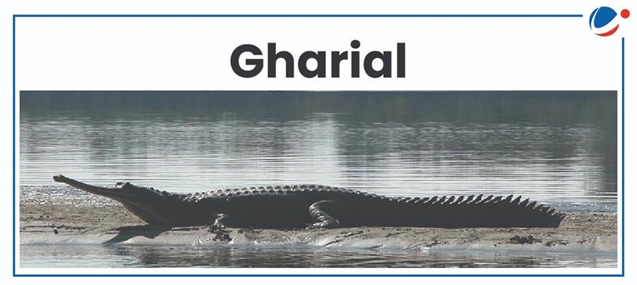Why in the News?
After 75 years, officials of the Forest Department confirmed the presence of Indian Gharial in Greater Kaziranga.
About Gharial
- Scientific Name: Gavialis gangeticus

- Conservation status:
- IUCN: Critically Endangered
- Wildlife (Protection) Act, 1972: Schedule I
- CITES: Appendix I
- Characteristics
- Gharial derives its name from ghara, an Indian word for pot because of a bulbous knob (narial excrescence) present at the end of their snout.
- Only mature males have this bulb.
- Gharials exhibit sexual dimorphism — or differences in characteristics between males and females of the same species — in both size and appearance.
- Unlike other crocodiles, the gharials feed on warm-blooded species and even the largest gharial adults feed exclusively on fish.
- Gharials are not man-eaters. Its jaws make it physically incapable of devouring any large mammal, including a human being.
- Habitat:
- Gharials reside exclusively in river habitats with deep, clear, fast-flowing waters and steep, sandy banks.
- Females lay their eggs in steep, sandy river banks.
- Distribution:
- Historically, the Gharial range spanned to Indus, Ganga, Brahmaputra and Mahanadi-Brahmani-Baitrani River systems of India, Bhutan, Bangladesh, Nepal and Pakistan.
- Currently, their major population occurs in three tributaries of the Ganga River: the Chambal and the Girwa Rivers in India and the Rapti-Naryani River in Nepal.
- Small populations are also found in the Ken River, Yamuna River, Brahmaputra River, Ghaghara River and Bhagirathi-Hoogly River.
- Major Threats: Alteration of habitat, Depletion of prey base due to increased intensity of fishing, destruction of the habitat, harvesting of eggs and poaching for the use of its body parts as medicines etc.
- Conservation Efforts:
- Project Crocodile was started in 1975 with the aid of the United Nations Development Programme and FAO.
- The Gharial reserves of India are located in three States – Uttar Pradesh, Madhya Pradesh and Rajasthan.
- In collaboration with the University of Tokyo, Japan and WWF-India has initiated a study on Gharial Bio-logging Science to understand the underwater behaviour and surrounding habitat of a free-ranging gharial.






